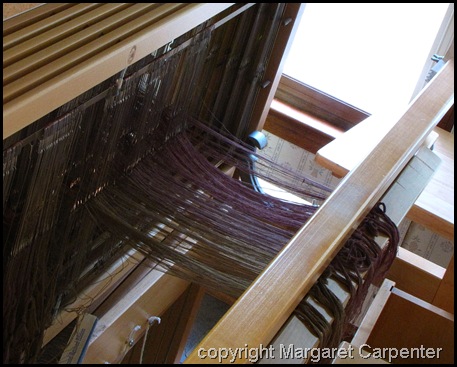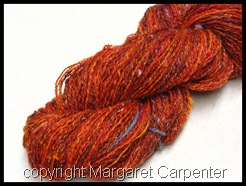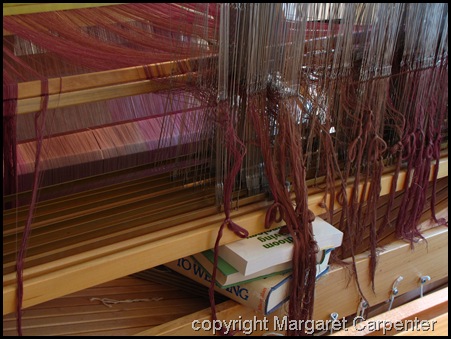Posted by Peg in South Carolina
At the front of the beater, you can see that I have tied the warp ends in groups and slip-knotted them. I have tied them in groups of 6-dents-worth. That is, 24 ends are in each knotted group. That is slightly more that one-half inch of warp—the size of the warp groups I will tie onto the front of the loom when I am done sleying.
POSITIONING THE BEATER FOR SLEYING
The beater would appear to be defying gravity in this photo. It is not because of the angle of the shot. It is because, on the left side of the loom, I have tied the beater to the frame so that what you see is the closest position to the front of the loom that the beater can fall. It’s also tied so it cannot fall complete to the heddles either. This makes for much easier sleying.
Some people like to have the beater straight up for sleying. I find being able to move it between this more forward position and back to a more leaning position in the opposite direction suits my technique better. One of the things I do, for example, when I am collecting the groups of thread to tie them is to look at them as they come from the reed at the rear side of it, holding the group taut with my hand. It is much easier for me to see that way than looking from the front of the beater.
USING THE AUTO-DENTER
 With my auto-denter, sleying a 15-dent reed (4 ends per dent) is easy, if slow, work. The auto-denter moves kind of automatically from dent to dent. I hear a click when it has moved successfully. If I don’t hear a click, I do it again. This greatly reduces the anxiety that comes from staring and staring at the gosh darn reed’s openings. That can leave me frazzled after awhile.
With my auto-denter, sleying a 15-dent reed (4 ends per dent) is easy, if slow, work. The auto-denter moves kind of automatically from dent to dent. I hear a click when it has moved successfully. If I don’t hear a click, I do it again. This greatly reduces the anxiety that comes from staring and staring at the gosh darn reed’s openings. That can leave me frazzled after awhile.
Still, it is sometimes not without its problems. The auto-denter did come apart at one point. This is not really a problem. It is made in two parts. If you look carefully at the photo, you can see where the two halves are joined. When they become separated, it is easy to put them back together. Because this happens so rarely, when it does happen I never remember exactly how to do it so I have to fiddle with it a bit to get it to work right. And the instructions that came with the tool are no help here.
TWO MISCELLANEOUS SLEYING ISSUES
1. I discovered that I had threaded two threads in one heddle. Clearly the two threads had kind of stuck together, as there was no threading error involved. So all I did was pull one thread out, unwind it and wound it around a bobbin. I will just gradually let it unfurl as I weave.
2. I discovered two threads that were crossed on the lease sticks. An easy fix. I unthreaded the two heddles and then threaded them in the correct order.
ON TO PART TWO
Now to see what will happen as I sley the second half of the warp.
Related Post: Sleying the Reed
“Sleying the Reed Half Done” was written by Margaret Carpenter for Talking about Weaving and was originally posted on June 30, 2010. ©2010 Margaret Carpenter aka Peg in South Carolina.






